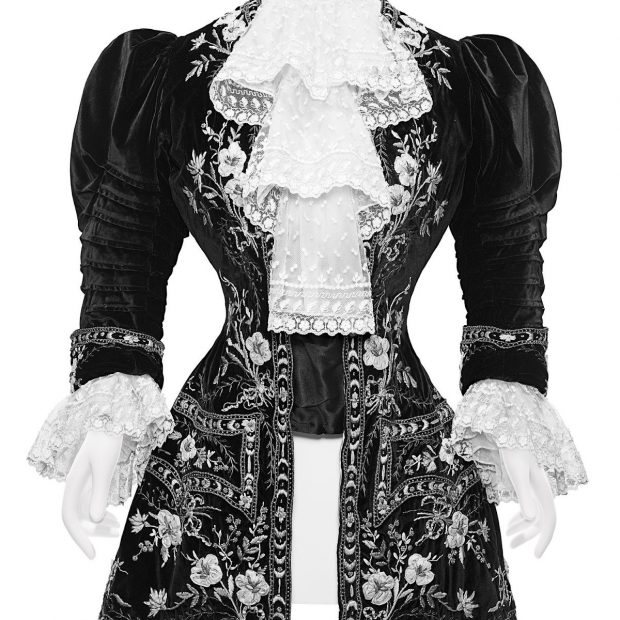
150 years of fashion for the 150th anniversary: The exhibition “About Time: Fashion and Duration” in the Metropolitan Museum in New York tells how women’s wardrobe has developed – and which ideas shape it to this day.
Old-fashioned. The word is a death sentence in the industry that lives from telling us that they are constantly creating new looks. For a long time now, the collections have changed more frequently than the seasons. It is seldom a radical change, as has recently been the case from skinny-fit to looser cuts. Usually, there are only small changes, but clear enough to be attractive. The wheel cannot be reinvented, but it can keep turning.
What is dusty today can be trendy again tomorrow, or the day after tomorrow. Everything is a question of time. That is why the new fashion exhibition in the New York Metropolitan Museum of Art is also called “About Time: Fashion and Duration”. So it’s about how the way of dressing has changed over time and why. She also deals with the question of how fashion designers inspire each other.

In principle, this jacket is sportswear. It was made to sit on a driver’s seat with it. Alexandra of Denmark, wife of the British King Edward VII, was photographed in it in 1902. The embroidery and motifs are based on the coats and vests of French noblemen from the 18th century. The silk ribbons and flowers applied to the lap were also popular in France until the revolution.
See also The Best Restaurants in the Meatpacking District: Add this to Your List
The exhibition organizers illustrate the cycle of trends, retro trends and revivals, the eternal play of “in” and “out” using clothes from the past 150 years. Because that’s how old the largest art museum in the United States will be this year. Curator Andrew Bolton weaves a thread from the impressionist fashions of 1870 to the fall-winter collections.
The fact that only women’s fashion is shown initially irritates, but it is the fault of the men: from the 19th century, with the beginning of the bourgeoisie in France and elsewhere, the men, at least equal to women in terms of fashion craziness, no longer competed for that most spectacular outfit. The triumphant advance of the suit, which has not changed much to this day, began. That would also be material for an exhibition, but not for this one.

Club sleeves were a thing long before 2004. They first appeared at the end of the 16th century. By 1890 they were very popular again. They were sewn to all kinds of clothes, including this evening dress made of black silk satin, probably from 1895. It was made in a studio in Brooklyn. The overemphasized shoulders are also accentuated by the narrow hips; together with the sweeping skirt, they form the hourglass silhouette that was popular at the time.
Looking back from yesterday to today is only one way of looking at the fashion treasures that have been collected. Each part is paired with a design that is similar in design, material, or idea to its ancestor but comes from a different era.
See also Little Island: New York Has a New Floating Park
For example, it becomes clear that the time when women with gymnastics fluffed their butts may have been a long time ago. It is not forgotten. In 1986, more than 100 years after the fashion revolutionary Charles Frederick Worth reintroduced the buttocks, Yohji Yamamoto inspired a series of coats. The Japanese cut the back free so that there is room for a sweeping cloud of tulle. The multi-layered ruffled fabric on the hips can also be found in the evening dress from 1885.

The exhibition is structured like a clock face
The Englishman Worth is considered to be the inventor of haute couture, but he too has only copied the “Wattehintern”. As early as the late 17th century, the ladies-in-waiting at Versailles had puffed up their mantles at the back. By the way, Worth only made the turnaround modern again to stimulate the French textile industry. The idea of fashion as economic development was not his either. Napoleon I was already so clever.
With other design pairs, the comparisons are less convincing. Even if the restriction to black dresses – a few are white or cream-colored – suggests a relationship. In some cases, the ensembles are at most similar in terms of their components. For example the ribbons on a two-piece by Viktor & Rolf from 2005 and an evening dress by Madeleine Vionnet from 1939. It takes a lot of imagination to see a spiritual connection here.
READ: Bedouins: From Camels to Toyotas
A tour through the exhibition, which is structured like two clock faces, or the 304-page catalog is still not a waste of time. They lead past designs for all the great French houses from Balenciaga to Vuitton. Big names like Lagerfeld, Margiela, McQueen, Jacobs, Versace and all the other usual suspects are of course represented. In addition, works with not so brilliant names are shown. Rudi Gernreich, for example, who, among others, inspired Azzedine Alaïa for his famous zipper dress, which in this case is unmistakable.
Everything has been there before, it’s all a matter of time.
Like us on Facebook for more stories like this: